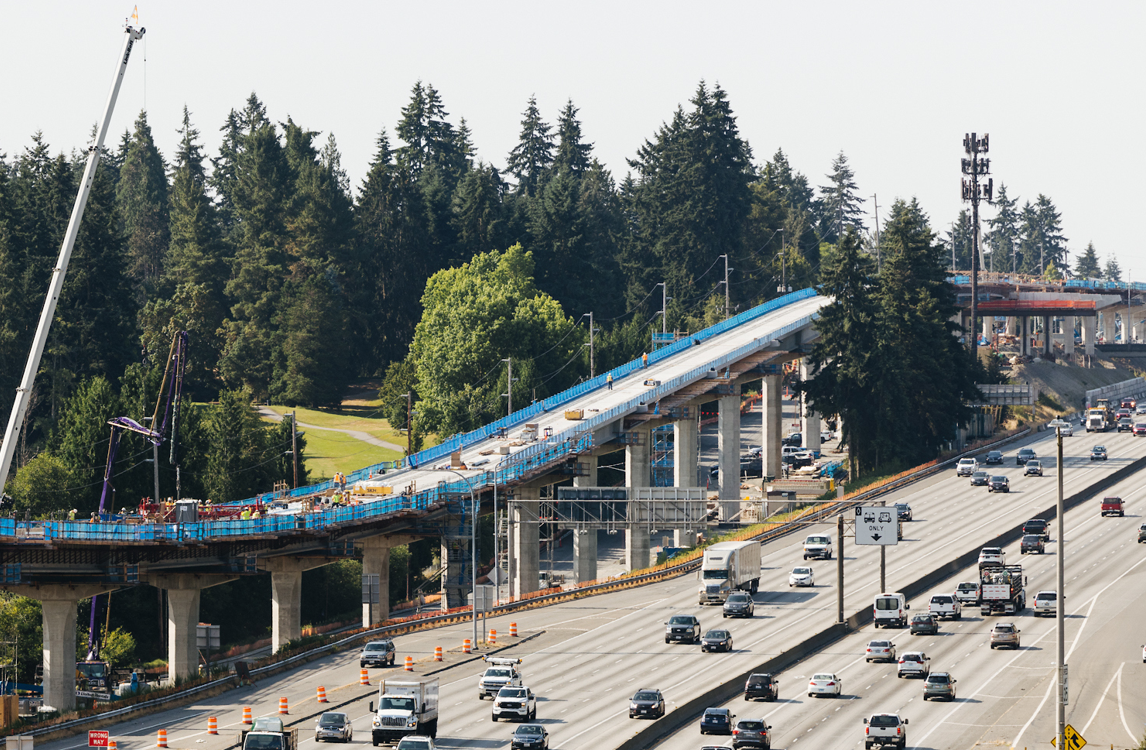Executive Summary
Sound Transit leases portions of state highway property from WSDOT for its light rail system
Sound Transit builds and operates public transit in the central Puget Sound region. It leases highway right of way (ROW)The property used for the construction, operation, or maintenance of a transportation facility. It includes the space located above, at, or below the highway's established grade line. from the Washington State Department of Transportation (WSDOT) for its light rail systemTransit that runs on fixed rails. Light refers to lighter passenger capacity, not the physical weight of the vehicles..
Before leasing to Sound Transit, WSDOT must determine that the property is not presently needed for motor vehicle transportation. The two agencies signed a Land Bank Agreement in 2000 that provides a framework for leasing and recording in-kind transactions. Sound Transit receives credits from WSDOT for funding transportation improvements that benefit state highways. So far, Sound Transit has earned enough credits to offset its total lease costs without having to pay cash.
The 2021-23 transportation budget directed JLARC to evaluate the method used for leasing highway ROW to Sound Transit for light rail development.
Sound Transit leases highway right of way at 100% of market value. Rates are based on the most commonly used corridor appraisal method and meet industry standards.
JLARC staff hired independent appraisers to review WSDOT's lease rates. The appraisers confirmed that the corridors were appraised at 100% of market valueThe amount of money a purchaser is willing to pay a seller for a property. Both parties must agree to the price and neither is obligated to purchase or sell. and that the methods used to calculate the lump sum lease payments were reasonable and supported by market data.
Other states do not charge transit agencies market value to use highway right of way
JLARC staff reviewed leasing practices in five statesCalifornia, Colorado, Minnesota, Oregon, and Virginia. with rail transit operating in highway ROW. Four of the five states do not charge public transit agencies to use highway ROW. The Oregon Department of Transportation charges Portland's regional transit agency to use highway ROW, but it does so at a discounted rate that does not include the federal share of highway acquisition and construction costs paid for by the federal government, typically 80%-90%.
The Land Bank Agreement would benefit from formalized procedures and more interagency cooperation
The Land Bank Agreement provides a framework for WSDOT to lease property to Sound Transit in exchange for its funding of highway improvements. WSDOT's engineers determine whether a project has a highway benefit and an internal committee makes the final determination on credits and costs.
WSDOT and Sound Transit have developed new practices since the Land Bank Agreement was last updated in 2003. They have not documented many of their procedures and formal interagency coordination is limited.
A proposed new Land Bank Agreement may reduce Sound Transit's costs by 57% through 2060, with cash savings of up to $569 million
WSDOT and Sound Transit are currently negotiating a new Land Bank Agreement that would extend lease terms and waive the federal share of costs on future ROW lease agreements. JLARC staff compared forecasts from the current Agreement with changes in a proposed new Agreement. The analysis shows that Sound Transit's aggregate highway ROW costs will decline from $1.4 billion to $606 million by 2060, a 57% reduction. Under the proposed new Agreement, the Land Bank is forecast to maintain a positive balance from 2027 to 2063, potentially saving Sound Transit $569 million in cash payments between 2049 and 2060.
Proposed new Land Bank Agreement reduces Sound Transit's long-term ROW costs by 57% through 2060

Source: JLARC staff analysis.
Legislative Auditor Recommendation
WSDOT and Sound Transit should strengthen internal oversight of the Land Bank Agreement and develop written procedures to jointly administer the Agreement. As the agencies negotiate an update to the Agreement, they may consider:
- Establishing formal procedures for interagency collaboration. These could include procedures for jointly preparing the Land Bank forecast and including Sound Transit in some Land Bank Oversight Committee ("the Committee") discussions.
- Incorporating new procedures developed since the last update in the new Agreement (e.g., using temporary construction leases, awarding credits based on actual expenditures, and describing the role of the Committee).
- Documenting when the Committee must vote on specific actions.
- Establishing and documenting criteria for highway improvement projects that are eligible for credit.
You can find additional information in Recommendations.













